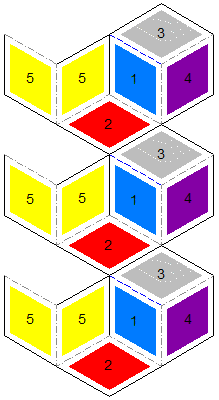

|
These flexagons are made from rhombuses, quadrilaterals where all four sides are equal length. Rhombus hexaflexagonThis flexagon is a bit tricky to make because the template overlaps itself in multiple places. To make this 6-sided rhombus hexaflexagon:


The rhombus I've chosen to use here has two 60 degree angles and two 120 degree angles. This means that the flexagon lies flat if there are 6 leaves (a hexaflexagon) and the central angle is 60 degrees. If one of the 120 degree angles are in the center, the result is greater than 360 degrees so it doesn't lie flat. This rhombus flexagon has similar behavior to various triangle flexagons, including the triangle hexaflexagon and star dodecaflexagon. In the video I show the pinch flex, tuck flex and silver tetra flex, which are similar to flexes on triangle flexagons. One interesting note is that the pinch can combine with the box flex to produce a new flex. |
